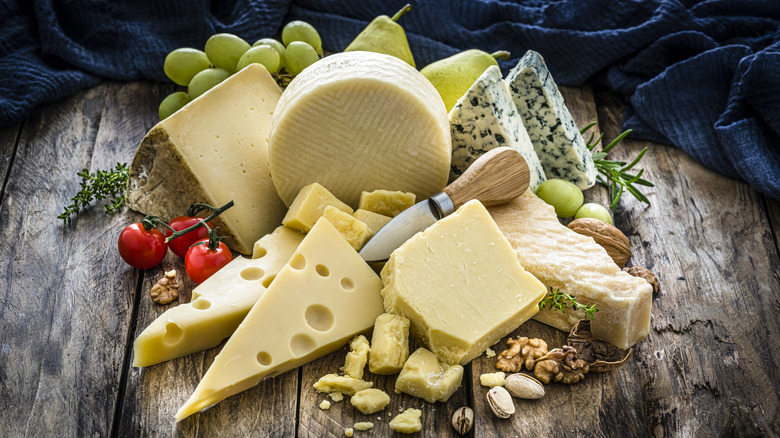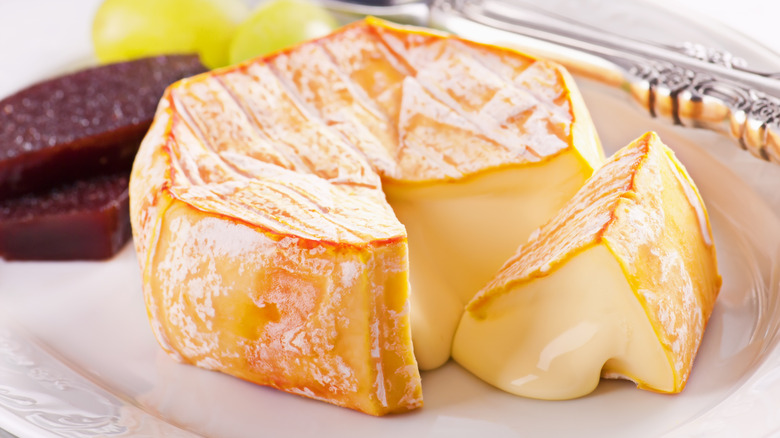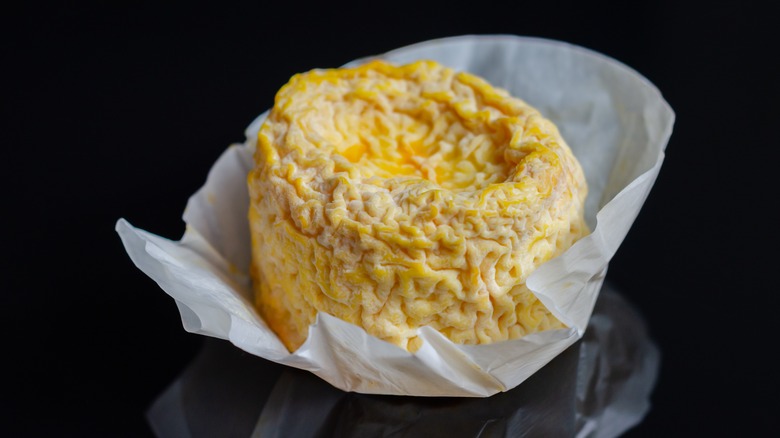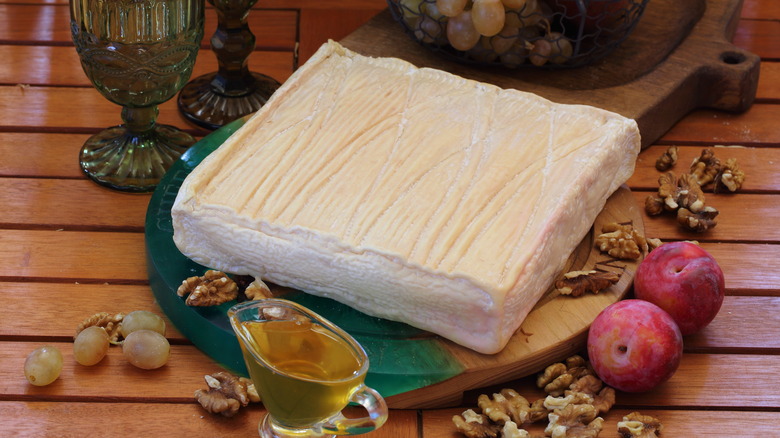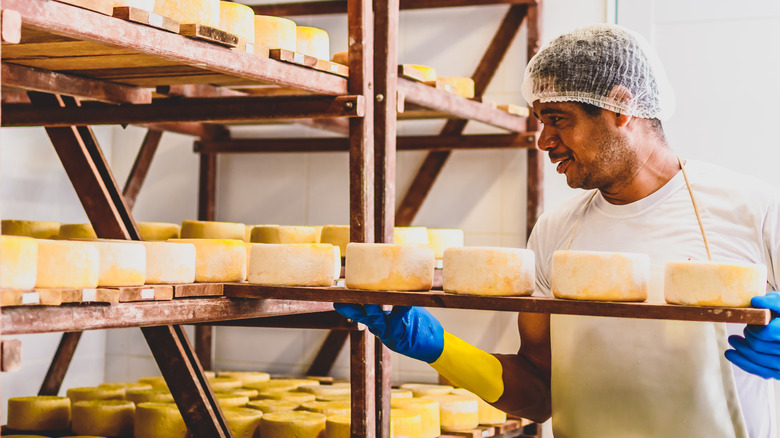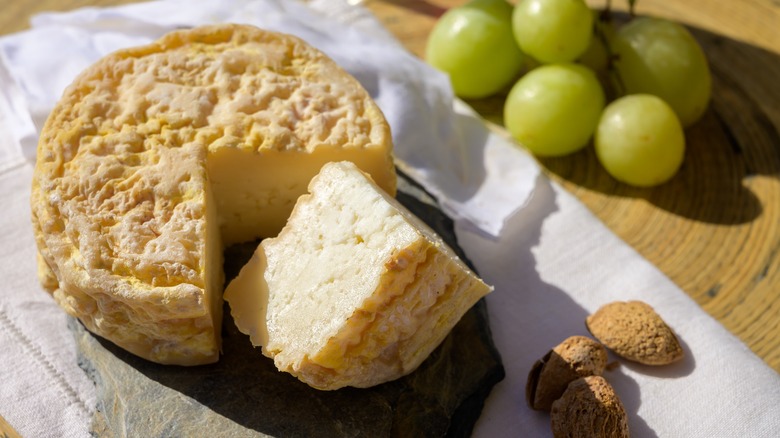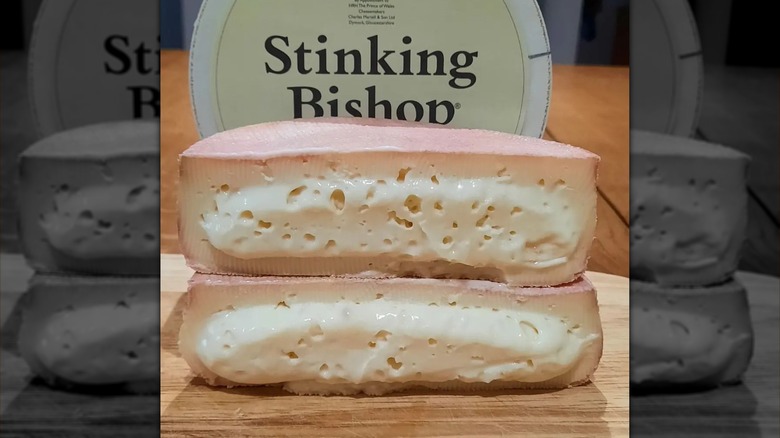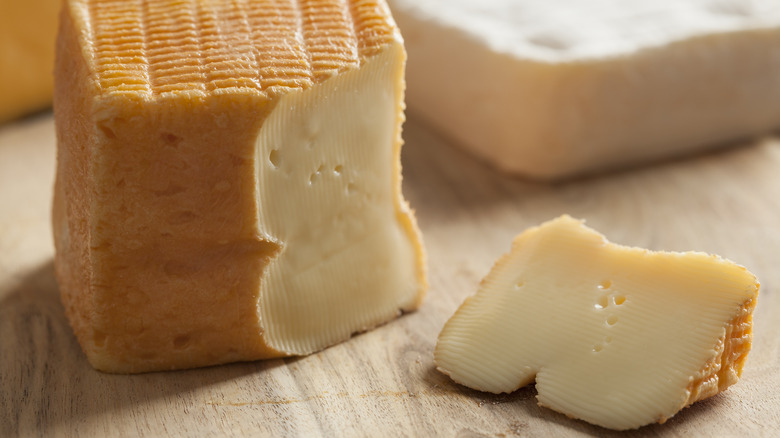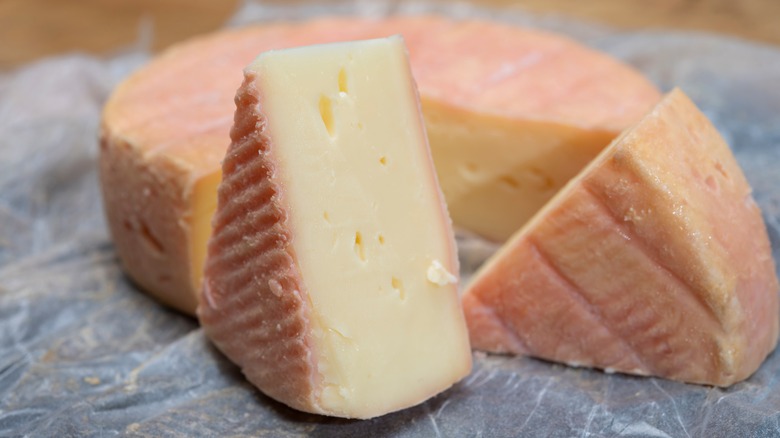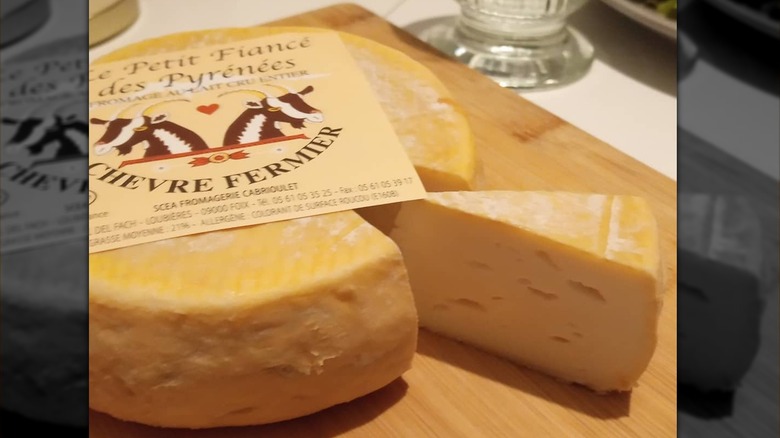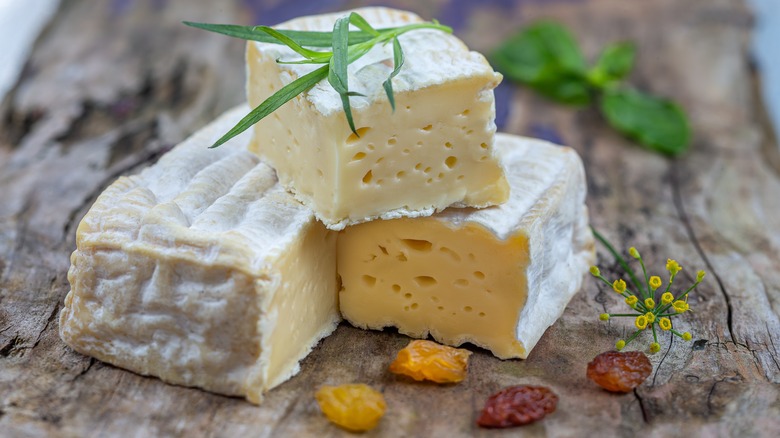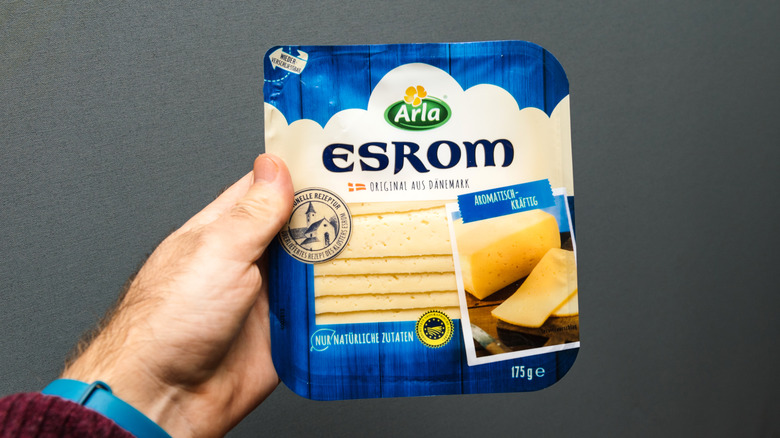12 Stinky Cheeses You Should Dare To Try
For some people, the thought of ripe, stinky cheese makes them recoil in disgust. For others, however, an eye-watering aroma from the cheeseboard signals a great culinary experience. Stinky cheeses are particularly popular in Europe — especially in France, which produces a high number of the world's ripest fromage.
All the cheeses featured here are washed rind cheeses. This refers to an artisanal cheesemaking process where milk is set with a coagulant, drained or pressed to remove the whey, brined with salt, and rested in a humid environment for several weeks. During rest, the cheese is repeatedly washed with salt water and bacterial cultures – or B Linens – to encourage mold growth. This is what gives stinky cheeses their scent and distinctive flavor.
Many washed rind cheeses have animal rennet added to help the milk set, although some cheesemakers use vegetarian alternatives. A strong smell does not always equal overpowering flavor, and stinky cheese is often light and creamy beneath the startling funk. For this list, I've searched the web for the stinkiest cheeses and included one of my favorites — Langres, a mild, creamy cheese from France. I've also sampled the infamous Époisses, which is known as one of the smelliest cheeses in the world and not one to leave hanging around in the fridge.
1. Époisses
Époisses is manufactured in Burgundy, France and is one of the most famously stinky cheeses on the market. Its pungent odor is so notorious that it is allegedly illegal to carry Époisses on French public transport. Although it does smell as strong as people say — think a combination of ripe gym socks, ammonia, and earthy fermentation — Époisses is a surprisingly mild cheese. Underneath the reddish mold rind, the cheese texture is gloopy and sticky, with a slightly shiny surface and a creamy taste.
Traditional European Époisses was first manufactured by French monks in Burgundy in the early 1500s. The recipe was passed on to local farmers in the nearby village of Époisses, who began regular production of this aromatic cheese. Époisses production was limited to this specific French region and now has a Protected Designation of Origin status under EU law. This means that genuine Époisses can only be made in this area.
The cheese is made by coagulating raw milk, separating the curds, and then washing the cheese wheels in B Linen cultures and local Marc du Bourgogne brandy to create a bacterial rind. You'll only find pasteurized versions of Époisses in the United States as products made from raw milk are prohibited by FDA laws. While pasteurized Époisses is quite similar in smell and taste to the original Burgundy cheese, it's well worth trying French Époisses if you're in Europe.
2. Raclette
Raclette is a fascinatingly stinky cheese that was invented in the Swiss Alps region. While the aroma of raw raclette is somewhat unbearable, the smell becomes more appetizing when the cheese is warmed through and melted. Traditionally, a half wheel of raclette is heated beside an open fire and scraped off to serve as the cheese turns soft. The name raclette comes from the French verb racler – to scrape – and also refers to the Swiss dish, raclette, which is melted cheese scraped over boiled potatoes, cold meats, and pickles.
As the cheese is heated and the odor disappears, raclette's flavor becomes mild and creamy. Melted raclette has a stretchy cheese pull and looks mouthwatering draped over burgers, crusty bread, or fries. Modern restaurants use a special heating apparatus to warm and scrape the cheese over dishes. It can also be heated in a non-stick pan and served in pots fondue-style, or heated under a grill or broiler to achieve the same effect.
Raclette is a cow's milk cheese and has a semi-firm consistency. It is washed with brine to create a firm, non-edible skin on the cheese surface. Due to its long aging process — raclette is generally aged for around three months – it has a low lactose content, as lactose is broken down by bacteria as the cheese matures.
3. Langres
Langres is known for its intense aroma combined with a surprisingly mild taste. This creamy washed rind cheese is made using warm cow's milk and hails from France's Champagne region. Langres is an excellent cheese to start with if you're hesitant about trying stinky cheeses. The odor and flavor intensify over time, so your Langres will smell quite tame for the first few days after purchase.
Even once the smell starts to kick in, the taste remains quite light and neutral compared with stronger washed rind cheeses, such as Époisses. Langres has a distinctive appearance because of its wrinkly, orange rind, which is achieved through multiple brine washes. The consistency is wobbly and sticky and Langres wheels usually have a slightly collapsed top, which is made by only resting the cheese on one side during aging. Traditionally, this dip would be filled with champagne or prosecco for truly decadent occasions.
The rind on Langres is also edible and blends in with the soft texture of the cheese. It's delicious served on crackers with a dry white wine or a creamy chardonnay.
4. Taleggio
Taleggio is an Italian washed rind cheese that is traditionally made in the Taleggio Valley in Lombardy. This remote mountain region was a place where cows often rested between grazing cycles. Locals in the area would use milk from these cows to make cheese, which they aged in the surrounding caves. Raw milk versions of Taleggio are still made in mountain regions, however, many modern Taleggios are now pasteurized.
This cheese has a complex aroma and a slightly tangy acidic taste, with fruity notes and an edible mold rind. During production, milk curds are separated from the whey and rested in molds to create Taleggio's classic square block shape. The cheese is brined and then washed repeatedly while resting. Bacteria from five separate mold types are used to promote growth on the Taleggio skin, creating its orangey-pink outer coating.
Taleggio is quite a wet cheese and spreads easily. It has a moderate acid content, which gives it a slightly zesty flavor. Traditionally it is aged for around 50 days, although Taleggio sold in the U.S. must be aged for more than 60 days.
5. Vieux Lille
Another French contender, Vieux Lille, or the aptly nicknamed "Lille Stinker," is famous for its overpowering scent. Vieux Lille is a brined cow's milk cheese and is most commonly associated with northeast France, around Lille. However, the cheese was not made in Lille. Instead, Vieux Lille is a type of Maroilles cheese, which was made in the nearby La Thiérache region and dates back to the medieval period.
Vieux Lille got its name because Lille residents would travel to La Thiérache to buy Maroilles in bulk and use salt jars to transport them. This salt brine effectively added another wash to the already pungent cheese, increasing the intensity of its smell and flavor. Interestingly, Vieux Lille was especially popular with French miners, who would enjoy it for lunch in the confined space of the underground pit.
Vieux Lille has a buttery texture and a semi-firm consistency. The high-fat content gives it a viscous richness that coats the tongue, while its brining process gives it a deep, salty flavor. In terms of aroma, Vieux Lille is not for the weak-nosed, and the intense fermented scent, mingled with notes of ammonia and rot, can take some getting used to. However, Vieux Lille's unique flavor, and the opportunity to try one of the smelliest cheeses in Europe, make sampling it worthwhile.
6. Serpa
Serpa is a traditional Portuguese sheep's cheese that can be soft or firm depending on how long it has been aged. Serpa is thickened using extracts from cardoon flowers, which are related to artichoke plants. This makes Serpa a slightly unusual example of a vegetarian-washed rind cheese. Many French and German washed rind cheeses are coagulated using rennet, which is a byproduct found in calves' stomachs, although vegetarian rennet is quite common in Portuguese cheesemaking.
Serpa is usually made from Lacaune sheep's milk in the southeastern Alentejo region. It is made into wheel blocks and washed repeatedly with brine as it ages. Serpa is aged for at least 30 days in Portugal, with U.S. versions being aged for the required 60. Serpa's strong, earthy smell is often described as being buttery with a sour milk tang. Younger Serpa is often softer and creamier, while aged Serpa has a slightly bouncy, farmyard cheese texture.
Serpa is similar to famous Portuguese cheeses like Serra da Estrela, another sheep cheese manufactured in the mountains of central Portugal. Try it with a full-bodied red wine from the Douro region for a true Portuguese feast.
7. Stinking Bishop
Although the U.K. does not have quite the same reputation for odiferous cheeses as France, Stinking Bishop is a British cheese that gives many French cheeses a run for their money. This challenging olfactory product was invented in the early 1970s by Gloucestershire farmer and cheesemaker, Charles Martell. It is a pasteurized cow's milk cheese made using milk from Gloucester cattle and is washed with Stinking Bishop pear cider. Bacteria in the fermented fruit give Stinking Bishop cheese its recognizable funk.
Stinking Bishop's scent is so hair-raising that it was given a starring role in the 2005 film, "Wallace and Gromit: The Curse of the Were-Rabbit." The cheese itself has a sticky, slightly runny texture and is usually firmer near the rind and looser, with gloopy eyes in the center. Beyond the smell, it's known for having a faintly meaty and earthy flavor — think bacon and mushrooms — and is can be aged for up to eight weeks.
Martell uses vegetarian rennet to coagulate the milk and set the cheese curd, meaning this is a great option for non-meat-eaters. Despite the startling smell, Stinking Bishop has a light, mild flavor that most dairy fans will enjoy.
8. Limburger
Originally made by Belgium monks in the 1800s, Limburger cheese is now mainly produced in Germany and is known for its musty, sock-like smell. Limburger is a smeared rind cheese that's washed repeatedly with brine and B Linens to encourage bacterial growth. It has the same orange or pinkish rind found on Époisses or Langres and a soft, sticky consistency inside.
Limburger is one of those cheeses that gets stinkier and more potent the longer you keep it around so if you don't think you can handle the funk, it's best to eat it within the first month. Cutting off the rind will also weaken the odor.
As well as Europe, this aromatic cheese is also produced in Wisconsin, where it has long been a popular favorite. The cheese was manufactured there by Swiss immigrants and was exported to cities with large German populations, like New York during the 1920s. Limburger sandwiches were a common workman's lunch during this time and were traditionally enjoyed with a glass of beer and with rye bread and onions.
9. Munster Gerome
Munster Gerome is a French soft cheese that comes from the Alsace-Lorraine region in France, just on the German border. It's made using milk from the Vosges mountain pastures. Vosgiennes cows are known for producing milk that's high in protein. This, combined with the high grazing altitude in the mountainous region, is credited with producing excellent local cheese.
Munster's pungent aroma gets a lot of attention — and for good reason. The odor is often compared with rotting hay or vegetables, farmyard animals, and fried eggs. If you can stomach all this though, you'll find that Munster has a creamy, slightly tart taste that's nowhere near as overpowering as its scent. Like other washed rind cheeses, the smell comes from the skin, which is created by bathing Munster in salt water and annatto – a natural red food coloring.
Munster Gerome is not to be confused with American Muenster cheese, which is a popular filler for grilled cheese sandwiches. Although Muenster does have some aroma, it is much more palatable than the French variant. Muenster dates back to the 1800s when it is believed that Wisconsin cheesemakers attempted to replicate Munster Gerome. Muenster is not washed multiple times or aged for long periods, which also reduces the potency of both taste and smell.
10. Le Petit Fiancé des Pyrenees
Le Petit Fiancé des Pyrénées is a goat's cheese from the Ariège region in the southern French Pyrénées mountains. This cheese is a rare example of a goat's cheese that is made like a cow's cheese. Instead of simply allowing the milk whey to drain out of the curds, Le Petit Fiancé des Pyrénées is pressed and then left to rest. During this rest period, it is washed repeatedly with brine, annatto, and fungal bacteria to help the cheese grow a thick, edible rind.
Le Petit Fiancé des Pyrénées was invented in the 1990s by cheesemakers, Philippe and Marie-Suzanne Garros, who fell in love in the Pyrénées and then settled there to start a cheesemaking business in Phillipe's native region. Le Petit Fiancé des Pyrénées goat's cheese has a buttery, slightly nutty flavor, with lots of earthy scent notes and yeasty fermentation. It is aged for three months, leading to its potent aroma.
Many people find the smell of goat's cheese off-putting because of its slightly acrid aroma, and aging does tend to enhance this. Goat's cheese lovers, however, will be delighted by this stinky little cheese and the adorable romance story behind it.
11. Pont l'Eveque
Pont l'Eveque is a Normandy cheese that has a buttery complexion and a soft, velvety texture. Around its soft center, this cheese has an edible washed rind which is revered for its mushroomy smell. Pont l'Eveque has been made in France since the 12th century, making it one of the country's oldest artisanal cheeses. It is usually made with cow's milk and is aged for up to two months in cellars with the correct humidity.
Flavor notes in Pont l'Eveque include a strong crème fraîche taste with a faintly nutty undertone. You will traditionally find it molded into square blocks with a dense white rind imprinted with a scored pattern. To safeguard the quality of this historic cheese, Pont l'Eveque has been awarded protected status by the EU. This means that only cheese made in the designated Normandy regions can officially carry the Pont l'Eveque title.
Serving suggestions for Pont l'Eveque include storing it at room temperature, to avoid hardening the cheese or changing its delicate flavor, and eating it alongside sweet, tangy fruits, like apple and grapes. This makes it a great cheese to try with some chutneys.
12. Esrom
Despite its characteristically punchy aroma, Esrom is a Danish cheese with a sweet, slightly spicy taste, which increases in complexity and savoryness as it ages. Unlike many French cheeses, Esrom is made from pasteurized cow's milk and has a semi-soft, bouncy texture and a vivid yellow color. Underneath the thin washed rind, the pate (inside of the cheese) is crammed with small eyes, which appear in the cheese due to the different bacteria strains used. Esrom is made into a loaf shape and is similar in taste and substance to French Port Salut cheese.
Esrom production is believed to date back to the medieval period in Denmark, but the recipe had largely died out by the 1900s. Interest in making Esrom revived during the 1930s, leading to a resurgence in this historic Danish cheese.
Esrom is a great cheese to try if you love strong flavors and melt-in-your-mouth softness. It pairs well with stouts, dark ales, or a deep red wine as the strong bitter flavor complements the cheese's subtle sweetness.
Methodology Slide
To research this article I sampled some of these cheeses including Langres and Époisses. I also looked at multiple online sources, including blogs and lists ranking the world's stinkiest cheeses. I then researched individual cheeses and cheesemaking techniques in greater depth using online sources.
